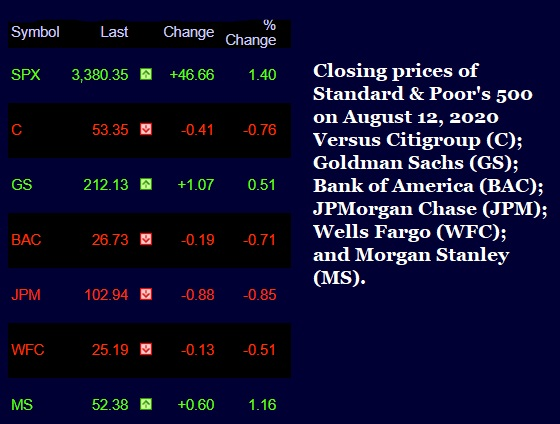Courtesy of Pam Martens
By Pam Martens and Russ Martens
The Federal Reserve has thrown everything just short of the kitchen sink at propping up the mega banks on Wall Street – the same ones that were never prosecuted for their fraudulent issuance of mortgage securities and causing the worse economic crash since the Great Depression in 2008. (The Fed bailed the same banks out back then also – to the tune of $29 trillion in cumulative loans.)
But yesterday’s market action suggests that something is definitely amiss. The S&P 500 index closed at 3380, just 7 points away from topping its all-time high of 3386 that it set on February 19 of this year. The Dow also gained 289.9 points on the day. But now look at the chart above. There was a sea of red in the Wall Street bank stocks. While the losses in Citigroup, Bank of America, JPMorgan Chase and Wells Fargo were all less than 1 percent, they stood out noticeably. For example, six of the Dow Jones Industrial Average components closed with gains of more than 2 percent. Those stock were Intel, United Health, Merck, Home Depot, Microsoft and Apple. (Apple actually gained 3.32 percent on the day.)
The action in the Wall Street bank stocks is particularly noticeable because Federal Reserve Chairman Jerome Powell has gone out of his way to repeat the following phrase at his press conferences and appearances before Congress: the big banks “are a source of strength” in this economic downturn. If they were actually a source of strength, shouldn’t their share prices be doing better than their corporate clients?
The reason that Goldman Sachs and Morgan Stanley went against the herd yesterday and closed in the green, is the perception that they are still predominantly investment banks and make less business loans than the big commercial banks like Citigroup, Bank of America, JPMorgan Chase and Wells Fargo. As the economy has dramatically weakened this year and corporate credit downgrades and bankruptcies increased, those commercial banks have been forced to set aside ever larger amounts for loan loss reserves, which eats into their profit picture.
…




